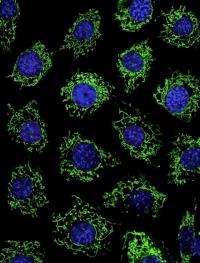Scientists identify calcium 'accelerator' to keep cell power supply going

A team of scientists from Temple University School of Medicine and the University of Pennsylvania has moved another step closer to solving a decades-long mystery of how the all-important flow of calcium into the cell's power source, the mitochondria, is controlled.
By painstakingly shutting down the activity of 50 genes, one at a time, they have identified a protein, MCUR1, which hugs the inside of the mitochondrial membrane and is part of an elaborate mitochondrial channel pore system. MCUR1 acts as an accelerator to help regulate calcium coming into the mitochondria from the cell's large reservoir.
The results, appearing November 25, 2012 in an advance online issue of the journal Nature Cell Biology, may also point to new treatment opportunities. Understanding how to manipulate MCUR1 may help in the development of treatments for disease conditions involving excessive calcium in the cell, such as cardiovascular disease and stroke.
"Calcium is a key to regulate many fundamental processes in cells," said co-senior author Muniswamy Madesh, PhD, Assistant Professor of Biochemistry at Temple University School of Medicine and a member of Temple's Center for Translational Medicine. "Excessive calcium in the cell's mitochondria could lead to heart and neuronal mitochondrial dysfunction and cell death. This pathway could be contributing to disease conditions during ischemia/reperfusion injury and stroke, and this discovery opens up possible therapeutic interventions."
Maintaining calcium at an appropriate level is crucial for cells to work properly, and especially important in the mitochondria. Cells rely on mitochondria to generate usable energy in the form of the chemical ATP, which is necessary to carry out normal cellular and metabolic activities. ATP production in turn depends on calcium – more specifically, charged calcium ions – that can enter into the mitochondria from the cell's vast supply in the cytoplasm. Dr. Madesh, co-senior author Kevin Foskett, PhD, at the University of Pennsylvania, and their co-investigators recently described the role of a gatekeeper protein in maintaining a calcium "set point" under normal resting conditions in the mitochondria. But a long unanswered question remained: the details of how calcium entry into the mitochondria is controlled.
How MCUR1 Dictates Calcium Load
In the current study, Drs. Madesh and Foskett and their co-workers may have come closer to solving this puzzle. Dr. Madesh and his group sought to identify the genes involved in the flow of calcium into the mitochondria. They developed a way to use a technology called targeted RNA interference (RNAi) to screen 50 mitochondrial proteins, systematically testing whether eliminating the function of each of these genes individually altered the movement of calcium into the mitochondria. They found a mitochondrial inner membrane protein – MCUR1 – that regulates a calcium channel pore during active calcium uptake.
MCUR1 is part of a calcium channel pore called the uniporter, the existence of which has been known for some five decades. Recent studies identified two important pieces of the pore – a subunit protein, MCU, and the gatekeeper protein, MICU1, to maintain calcium levels at a resting, set point. The researchers found that MCUR1 interacts with MCU to accelerate the movement of calcium into mitochondria when the cell's calcium level rapidly rises.
"MCUR1 is an essential third component of the uniporter complex," Dr. Madesh said. "In the absence of MCUR1, mitochondrial calcium uptake is markedly reduced, with adverse cellular consequences, including compromised cellular bioenergetics."
Without this accelerator, the mitochondria channel pore alone cannot take up calcium. When MCUR1 is physically attached to the pore, it is functional, and when it is not attached, it is much less active. "The regulator is always on, and its activity level increases when the extra-mitochondrial calcium levels increase. When there is a high calcium level, say during a disease state, the MCUR1 senses this and facilitates the channel activity, dumping calcium inside," Dr. Madesh explained.
Calcium Control as a Targeted Therapeutic
Dr. Madesh explained that in some disease conditions – such as ischemic reperfusion injury (tissue damage that occurs when blood returns to tissue after a period without oxygen), stroke involving brain injury from ischemia, and myocardial infarction – calcium floods into the mitochondria. "The mitochondria have a massive membrane potential and grab external calcium. The mitochondria then are overloaded and rupture, leading to cell death and possible organ injury."
Because some diseases are characterized by an overabundance of calcium in the mitochondria, a possible therapy could involve slowing down the amount of calcium coming into the mitochondria. "We want to control the calcium entering the mitochondria," he said.
"Further studies already underway should reveal the precise molecular mechanisms by which MCUR1 accelerates the channel pore MCU, providing insights into mitochondrial bioenergetics," said first author Karthik Mallilankaraman, PhD, a postdoctoral fellow in the Department of Biochemistry and the Center for Translational Medicine at Temple University School of Medicine.
Journal information: Nature Cell Biology
Provided by Temple University















